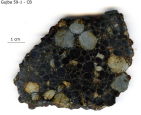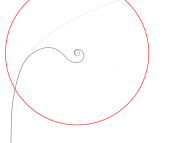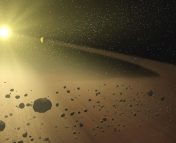- Title: A critical analysis of shock models for chondrule formation
- Authors: Stammler & Dullemond
- First Author’s Institution: Heidelberg University and International Max Planck Research School for Astronomy and Cosmic Physics , Heidelberg
- Paper Status: Accepted for publication in Icarus
Extraterrestrial rocks are important

Fig. 1: A chondrite from Gujba. Most of the small roundish pieces are chondrules. (Image adopted from J. Bollard)
What’s a chondrule? Never heard of that before. That’s probably your first reaction after reading this esoteric-sounding word. However, you’ve probably heard about meteorites before. Meterorites offer an insight in the compositions at different locations in our solar system. Particularly, unmodified meteorites, i.e. bodies with no differentiation or melting, can help to explain the origin of planetary systems. These unmodified meteorites are called chondrites (Fig. 1) and their most important components are small grains of a few mm to cm size, namely chondrules. Measurements of radioactive elements (short-lived radionuclides) in chondrules constrain their formation to the first few million years of the solar system. Remember that the solar-system itself is about 4.6 billion years old.
Thus, chondrules are the building blocks of our solar system. However, it is unknown how these grains of dust formed initially. Imprints on chondrules reveal that they must have been heated almost instantenously before they cooled within a few hours. These time-scales are very short compared to the millions of years of solar nebula evolution. One suggestion is that nebular shockwaves allowed a fast formation of chondrules. The shock induces efficient heating, which caused melting of dust. Subsequently, the melted dust forms droplets, which cool and finally solidify to chondrules.
A simple model of shocks
Imagine a shock as a discontinuouity travelling through a medium. Roughly speaking, the authors investigate the following sequence of events. The shock induces a quick increase of the dust temperature to a peakvalue T_peak. After the shock event the temperature falls off again and settles to a lower constant temperature, so called post-shock temperature T_post.
It is the aim of the paper to test chondrule formation for different conditions. The authors carry out simulations, which solve a radiative transfer model in one dimension, to estimate the evolution of the temperature.
The authors distinguish between local shocks, such as planetasimal bow shocks, and global shocks, induced by gravitational instabilities for instance. You can imagine a local shock as a small hot bullet, which is put into a bucket of cold water. The hot bullet can radiate its heat into all directions thus the temperature drops very quickly. In contrast, a global shock can be described by a hot plate being put into the bucket of cold water. When one part of the plate radiates into the cold water, it radiates into regions, which are already heated by another part before. Hence, the cooling process for the plate, i.e. global shocks in general, is less efficient.
Results: Shock-induced formation of chondrules is at least difficult
First the authors examine the temperatures for global shocks and high opacity. They did that by plotting the peak temperature of the shock and the temperature after the shock with respect to the shock velocity for three different densities (Fig. 2). You can see there is no velocity where the peak temperature exceeds the temperature required for melting (upper solid line) and the post-shock temperature is low enough to avoid evaporation of volatiles (lower solid line). The authors conclude that chondrules cannot be formed by global shocks in a medium with high density, because emitted photons are likely to be absorbed by other particles again. Thus, it is diffcult to get rid of the thermal energy in this region. Formally speaking, cooling is less efficient in an optically thick medium. The situation is different for local shocks in an optically thick medium instead. These shocks might have the right conditions because of the possibility of more rapid cooling.

Fig. 2: The peak and post temperature with respect to the velocity of the shock for three different densities (left: 10⁻⁹ g/cm³, middle: 10⁻⁸ g/cm³, right: 10⁻⁷ g/cm³). As one can see there is no velocity for which the peak temperatures can exceed the minimum temperature required for melting (upper solid line), and the post-shock temperature is beneath the maximum temperature required for solidification (lower solid line).
In the case of low opacity for global shocks, it is easier to radiate energy away because the radiation is blocked less by the surrounding. However, the escape of radiation energy turns out to be so efficient that the temperature already drops below the evaporation temperature after only a few minutes. This evolution of temperature disagrees with imprints on chondrules, too. Now you might think that if cooling is insufficient in one case and overly efficient in another, let’s look for the sweet spot in between! Unfortunately, such a spot does not exist for global shocks according to the authors.
Conclusion and Discussion: What comes next?
The conclusion of the paper is that formation of chondrules via global shocks is impossible because the induced cooling is either too weak (optically thick case) or too strong (optically thin case). However, local shocks in an optically thick medium could have the characteristic properties because the temperature can drop faster than for global shocks.
But are these simulations anything like a real protoplanetary disk? Well, the model is idealized in several senses. Most important, it only takes into account a one-dimensional model of radiative transfer, while protoplanetary disks are three dimensional. Furthermore possible processes such as nucleation and condensation are missing and only hydrogen dissociation and recombination is taken into account. Nevertheless, it is rather unlikely that adding more physics changes the general conclusion of the paper drastically. However, mentioning the problems and difficulties producing the appropriate conditions for chondrule formation via shocks raises doubt to the fundamental concept of shock-induced formation. Maybe chondrules are generally formed through a different mechanism instead?





Chondrules have been a subject of controversy for decades. Many theories of their formation have been discarded because of the lack of “half-baked” or “double-cooked” examples. The near-by supernova explosion scenario fits my favorite theory and also suggests a mechanism for the collapse of the original nebula. What say you?